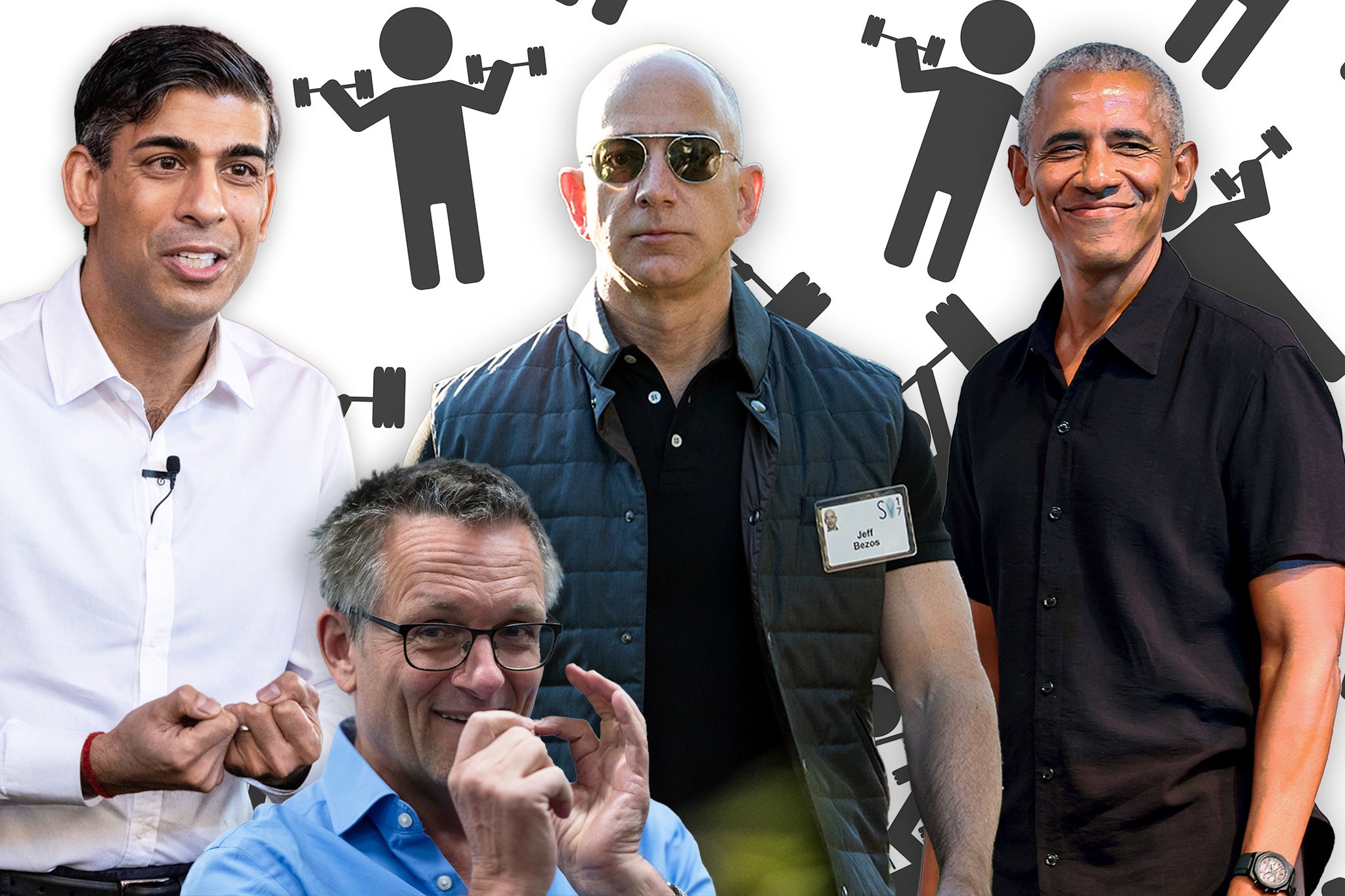From fasting to mindful eating – what is the secret to staying slim and healthy for a man over 40?
Our prime minister fasts for 36 hours and mindful eating is said to be how Obama has avoided a mid-life paunch. With so much conflicting advice around, Maria Lally takes a look at the mid-life men in the health spotlight right now to see if what they are doing could work for you


Former prime minister Winston Churchill’s favourite breakfast was said to be a full English, served with several slices of buttered toast and a glass of wine.
Our current prime minister Rishi Sunak, on the other hand, is said to survive on water and black coffee from 5pm on a Sunday to 5am on a Tuesday: “It’s true, he doesn’t eat anything at all on a Monday,” a source recently. “He is incredibly disciplined.”
He’s not the only one. Pictured at No 10 this week, much fanfare was made about Obama’s trim figure and how he has managed to avoid middle-age spread at the age of 62. Meanwhile, 60-year-old Jeff Bezos’s “monster workouts” are never far from the headlines too.
But, with new research from the American Heart Association published this week finding that limiting mealtimes to just eight hours a day was linked to a 91 per cent increase in risk of death from heart disease, what does science tell us about staying fit and healthy after 40 and beyond?
Fasting facts V fiction
Our 43-year-old prime minister has spoken before about fasting, which is part of his Hindu religion. And last week he told the BBC, “I tend to try and do some fasting at the beginning of every week as part of a general balanced lifestyle.”
He’s not the only midlife male faster. Last year, 46-year-old Chris Martin told a podcaster about how he restricts food, “I actually don’t have dinner any more. I stop eating at 4pm and I learnt that from having lunch with Bruce Springsteen.” The 74-year-old singer only eats one meal a day, as does Jack Dorsey, the former CEO of Twitter.
However, researchers, led by Dr Victor Zhong of the Shanghai Jiao Tong University School of Medicine, analysed approximately 20,000 adults in the US with an average age of 49 years who had followed intermittent fasting, also known as the 16:8 plan.
According to the study – which was presented at the AHA’s Epidemiology and Prevention conference in Chicago, Illinois – those who limited their eating to eight hours a day were 91 per cent more likely to die from cardiovascular disease than those who ate across 12 or 16 hours. Among participants with existing cardiovascular disease, an eating duration between eight and 10 hours per day was also associated with a 66 per cent higher risk of death from heart disease or stroke.
However, other research suggests there are clear benefits. For example, a 2023 study from the University of Utah found that intermittent fasting may help you live longer, while researchers at the University of Alabama at Birmingham found eating all your meals between 7am and 3pm (known as time-restricted eating) can improve blood pressure and mood, and help with weight loss.
“The science behind fasting is a well-held theory – if a little debated,” says personal trainer Matt Roberts, who has worked with Sunak’s colleague David Cameron. “It helps the process of autophagy, which dumps old cells that, when they don’t get taken out of the system, begin to impact the healthy cells around them. Fasting helps process them, which is thought to improve longevity.”

Doctor and TV presenter Michael Mosley developed the Fast 800 diet with the specific aim to reduce type 2 diabetes and heart disease – with the thinking that the very low-calorie diet may put type 2 diabetes into remission – especially if you carry excess abdominal fat, which is where many men in midlife store it.
Whether you fast or not, Roberts says thinking about your diet in midlife is key: “Men’s body fat increases as they reach their forties and fifties, largely due to slowing metabolism and decline in testosterone, which causes them to lay down fat around their middle. And that also includes internal, visceral fat, which can increase our risk of diabetes and heart disease.
“Exercise is crucial, but you also need a good midlife diet that includes a wide variety of plants, some healthy carbs, lean protein, fish, a little red meat, and healthy fats from nuts, seeds, avocado, and olive oil. And cut back on alcohol, which is full of empty calories, affects gut health, and hampers your ability to digest food.”

Be mindful like Obama
He might be 62 and have the grey hairs to show for it, but there are few midlife men who wouldn’t like to be as trim as the former president of America.
So how does he do it? As well as a love of hiking and basketball, the former president is also a mindful eater, snubbing ultra-processed food which is high in fat and sugar for healthier alternatives. When in office his wife, Michelle Obama, launched a healthy eating initiative for the nation’s children and created an organic kitchen garden on the grounds of the Whitehouse. Although Obama did indulge in some bad habits while in office such as smoking, an unhealthy diet wasn’t one of them.
At the Whitehouse, he enjoyed organic “field to fork” salads and fresh vegetables and his breakfast was a choice of scrambled eggs with some toast or fruit or porridge. Chicken or fish are usually chosen over fatty red meat and he avoids anything battered or fried. Even when on the road or working late he would avoid fast food – his go-to snack pistachios and almonds. However, he has disputed the once-reported detail that he had a seven-almond rule.
Ultimately, it is a very intentional way of eating. President Biden is also no slouch when it comes to his health regime. At 6ft tall, he weighs 178lbs and this has been put down to a daily routine that often incorporates weightlifting, Peloton and a lunch of soup and a salad (washed down with orange Gatorade). For dinner? A simple bowl of pasta and tomato sauce.
Like a lot of former presidents, he also likes a round of golf (he’s a member of Wilmington Country Club in Delaware, and according to Golf Digest is tied 68th among well-known Washington DC players, with a 10 handicap).
Build it like Bezos
Bezos’s fiancee Lauren Sanchez recently told Vogue magazine that while the couple work out together, “We cannot do the same exercises. He’s on a whole different level than I am. He is a monster in the gym.” Amazon boss Bezos has started working out with trainer Wes Okerson, who has trained Tom Cruise, and lifts weights, rows, kayaks, runs hills and paddleboards, along with eating a Mediterranean-style diet with fish, plants, and healthy fats.

“The key thing to remember as you reach midlife is you’re at the risk of an almost silent amount of plaque building up in your arteries and raised cholesterol levels, both of which increase your risk of heart disease,” says Roberts.
“From the age of 40, levels of testosterone produced naturally in the body also begin to decline, which means men begin to lose muscle mass, their mood dips and brain fog sets in. But this isn’t an inevitable part of ageing: I’m 50 and my body fat percentage and dimensions are the same as when I was 20. Developing a paunch isn’t an inevitable part of ageing.”
Roberts advises his midlife male clients to lift weights two to three times a week, which raises testosterone, improves muscle mass, and reduces fat. A recent study in the British Medical Journal found that 30-60 minutes of weight lifting (which can include using your own body weight, for example, planks or push-ups), reduced a man’s risk of heart disease by 10-20 per cent.
“And do some low-key cardio for 40 minutes around 3-4 times a week, which is a very efficient fat burner, and reduces arterial plaque and cholesterol. This might be a brisk walk, slow jog, or steady bike ride.” Zone two is where you’re using about 60-70 per cent of your heart rate (“you can still hold a conversation,” says Roberts), and on a scale of one to 10 in terms of exertion it’s about a six. As well as preventing injury, it causes your body to use fat as its main source of energy.
Research from the British Heart Foundation recently found that the average man in the UK spends a fifth of their lifetime sitting down, but Roberts says there’s no excuse: “I know from my time working with David [Cameron] when he was in No 10, doing the same job as Rishi is now, that it’s a busy life. You don’t have to go to the gym for an hour, but you can lift weights in front of a YouTube video for 10 minutes during your lunch break. Or go for a brisk walk before work.”
Boost your brain power
A recent study from the University of Exeter found that playing an instrument or singing in a choir may reduce dementia risk among the middle-aged. The researchers found that musicians have sharper memories and younger brains, especially those who play the piano. The experts added that the social side of choirs was good for the brain.
“This study is one more piece adding to the jigsaw about the effects of music on the brain,” says Professor James Goodwin, director of science at the Brain Health Network, and author of Supercharge Your Brain.
“No other single human activity engages as many parts of the brain simultaneously as does music, which also has a positive effect on our wellbeing, one of the three main pillars of brain health. The other two being our thinking skills and our social cognition, in other words, how well we interact with others.”

Moreover, Professor Goodwin says music often involves learning: “Psychologists call these types of activity ‘cognitively stimulating’ and these activities have been shown to benefit our thinking skills, which help us to maintain our thinking skills and our working memory. The learning aspect also explains why just listening to music appears to have fewer benefits. There’s little evidence that brain training games improve our brain health, but things like learning a new language, jigsaws, or even learning a new card game do.”
Professor Goodwin says that as we age, our increasingly sedentary lifestyles “become the assassins of brain health. One of the most noticeable changes from midlife onwards in men is a decrease in their activity levels and it becomes increasingly difficult for us to motivate ourselves to get out of the chair. Over many years this has a devastating effect on our inflammation levels, which is the enemy of brain health.”
Becoming more active can reverse brain ageing because exercise starts a process called neurogenesis, which is the growth of new cells. “I would recommend all midlife males watch less TV, sit less, and move around more. A teaspoon of Marmite is also helpful because it contains vitamin B12, which is important for brain health.”
Another little talked about area is sexual activity, which Professor Goodwin says boosts brain health, but tends to decline as we get older. “The gold standard in midlife appears to be once a week, which has been shown to improve our memory by up to 20 per cent,” he says.





Join our commenting forum
Join thought-provoking conversations, follow other Independent readers and see their replies
Comments